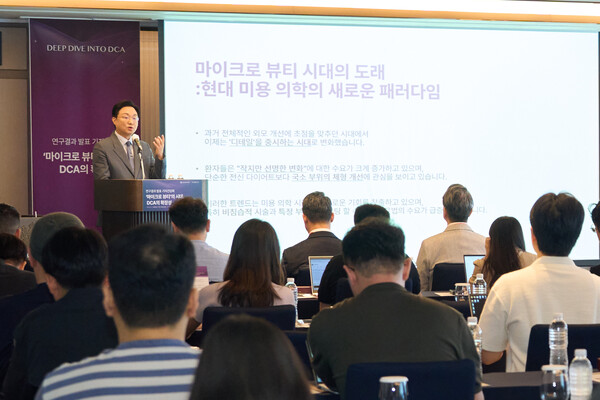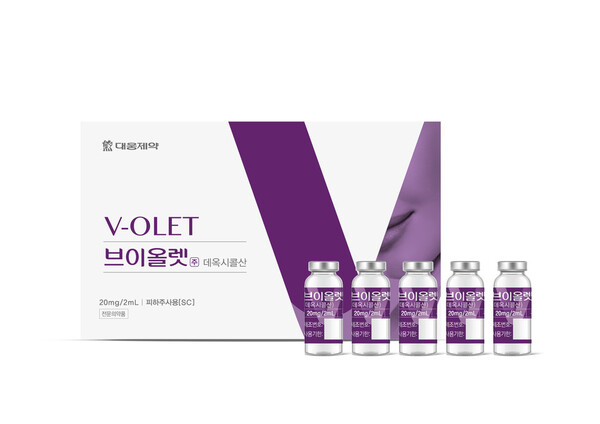
While blockbuster weight-loss drugs like Wegovy and Ozempic (semaglutide) melt pounds from head to toe, Korean drugmaker Daewoong Pharmaceutical is betting patients care just as much about where fat stays as where it goes.
In Korea’s precision-driven aesthetic medicine market, a drug once limited to dissolving fat under the chin is finding new use in less forgiving terrain: arms, thighs, even the folds beneath the buttocks. The shift signals a growing demand for site-specific contouring in the age of total-body weight loss.
At a press briefing in Seoul on Tuesday, Daewoong outlined its ambitions for V-OLET, an injectable treatment formulated with deoxycholic acid, or DCA.
The drug is currently approved in Korea for submental fat, commonly known as a double chin.
But physicians at the event, joined by the head of Daewoong’s Nabota division (its BTX unit), said the drug is already being used off-label to target areas of the body that resist both diet and GLP-1 drugs.
“Patients are increasingly looking beyond BMI or general weight loss,” said Park Je-young, a dermatologist and director of Apgujeong Oracle Clinic, during the event. “They want fine-tuned, detail-oriented contouring. GLP-1s like Wegovy can cause overall slimming, but that often means losing volume where it should be preserved.”
The message was clear: weight loss is everywhere. What matters next is deciding where it shouldn’t be.

Unlike traditional fat-dissolving injections, which rely on steroids or stimulants and merely shrink fat cells, DCA destroys them. Park explained that most early formulations used systemic drugs like aminophylline or dexamethasone, repurposed off-label for fat reduction.
While effective at shrinking fat cells, they often came with side effects such as hormonal disturbances and required large doses.
“They weren’t designed for this purpose,” said Youn Choon-shik, director of Yemiwon Dermatologic Clinic, who recently published a study on DCA in the Journal of Cosmetic Dermatology. “What we’re using now is a localized, targeted agent. It kills the fat cell itself.”
The process, called adipocytolysis, works by rupturing the cell membrane. That distinction matters, Park said, because shrinking fat cells allows for rebound. Killing them prevents it.
“There are two concepts: lipolysis, which reduces fat volume temporarily, and adipocytolysis, which eliminates fat cells altogether,” Park said. “When you destroy the cell, the effect holds, even with modest lifestyle changes.”
That’s not the only advantage. While liposuction removes fat rapidly, it also strips away the layer that supports skin, sometimes causing sagging. DCA, by contrast, triggers mild collagen regeneration, tightening the skin as it thins.
Park noted that the treatment may be especially effective in East Asian patients, who tend to have thicker dermal and subcutaneous layers. That structural difference, he said, makes Korea and the broader Asian market especially well-suited to DCA-based therapies.
Still, not all fat is created equal. Park described the physiology that determines why some fat disappears quickly and some clings on, no matter the effort.
“The fat people want to keep -- under the eyes, in the breasts -- tends to melt first. Meanwhile, areas like the jowls or double chin are the last to go,” he said. “That’s because those areas are rich in alpha-2 adrenergic receptors, which block fat breakdown. The places people want to slim most are biologically designed to hold on.”
This, he said, is where GLP-1 drugs fall short. While effective for overall weight loss, they are indiscriminate. DCA, he argued, offers a more surgical approach, without the scalpel.
“What if a patient is already thin, or doesn’t want to lose weight everywhere?” Park said. “That’s where this fits.”

New data presented by Youn supported the drug’s potential beyond the face. In a study of four women, each received three doses of DCA injected into the backs of their upper arms. Both low and moderate doses reduced arm circumference and subcutaneous fat thickness. The lower dose group experienced significantly less pain.
“The results confirm that diluted DCA injections can offer a minimally invasive option for upper arm fat reduction,” Youn said. “It gives clinicians a way to adjust dosing based on patient tolerance and desired outcome.”
For Daewoong, that flexibility is key. The company has completed four large-scale trials in Korea, enrolling over 960 patients, and V-OLET remains the only fat-dissolving treatment in Korea to complete both a phase 3 trial and a post-marketing safety study. Yet its official label remains limited to the chin.
“We’re planning to convert off-label use into approved indications,” said Yun Jun-soo, head of Daewoong’s Nabota division. “Before filing, we need data on safety, dosage, and site suitability. That’s what the investigator-led trials are for.”
Some of those trials are already underway. Yun said the company would pursue additional approvals in other Asian markets, starting with countries where Nabota is already established. V-OLET was cleared in the Philippines in December 2024.
Related articles
- Daewoong launches Botox rival Nabota in Qatar, completing Gulf rollout
- 'UDCA prevents gallstones in patients undergoing rapid weight loss with GLP-1 drugs'
- Daewoong launches Nabota in Ecuador
- Daewoong secures landmark BTX export deal in Latin America
- Daewoong and Medytox to vie over submental fat reduction injections
- Korea’s 365mc opens AI fat-removal clinic in Los Angeles
- Daewoong Pharmaceutical taps ex-Celltrion exec to lead global biosimilar push
- Daewoong expands Middle East presence with Nabota launch in Kuwait
- Wegovy proven effective in East Asians with lower BMI, 1st study confirms
- Daewoong Pharm expands Nabota Master Class to train global doctors, strengthen K-beauty leadership

